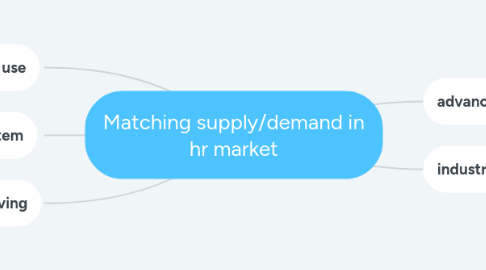
1. ease of use
1.1. one click UX
1.2. auto job description
1.2.1. AI algorithm
1.2.2. sophisticated, real time data analysis
1.2.2.1. continuous updates from database
1.2.2.2. minimum 70 % of the market resumes and 30 % of all employable population
1.2.3. three options of job description
1.2.3.1. fully automated job description
1.2.3.1.1. calculated from the position averages and/or skills available for salary
1.2.3.2. prompted job description
1.2.3.2.1. recommendations for the position + information about the averages
1.2.3.3. individual job description
1.2.3.3.1. according to the pre-set structure
1.3. minimalistic design
1.4. uniform structure
1.5. easy to manage profiles
1.5.1. job seeker
1.5.2. company profile
2. advanced matching system
2.1. AI data analysis
2.2. continually updated criteria for matching
2.2.1. individual for each position
2.3. no final decision is given without real time consent for both parties
2.4. matching according to:
2.4.1. company corporate culture
2.4.2. desired location
2.4.3. desired benefits
2.4.4. specific skils needed for the job
2.4.4.1. hard
2.4.4.2. soft
2.4.5. education
2.4.6. experience
2.4.7. other relevant data
3. career building system
3.1. industry information
3.2. resources (educational + coaching)
3.3. psychological testing
4. time saving
4.1. auto verification
4.1.1. education
4.1.2. employment
4.1.3. recommendations
4.1.4. mandatory documents
4.1.5. testing with gamification
4.1.5.1. language
4.1.5.2. skills (according to position)
4.1.5.3. speaking, etc
4.1.5.4. psychological tests
4.2. easy data upload and sharing
4.2.1. personal documents
4.2.2. diplomas and certificates
4.2.3. tests and such
4.3. easy communication
4.3.1. video conferences
4.3.2. messaging system
4.3.3. callendar
4.3.4. recruiting platform
4.3.4.1. schedule
4.3.4.2. candidate scorecard
4.3.4.3. decision making tool
4.3.4.4. templates for decision communication
4.3.4.5. feedback system
5. industry information supply
5.1. recommendations according to supply/demand analysis
5.1.1. salary recommendations
5.1.2. position recommendations
5.1.3. specific skills recommendations
5.1.4. specific task recomendations
5.1.5. specific profession/profession recommendations (according to the skills)

